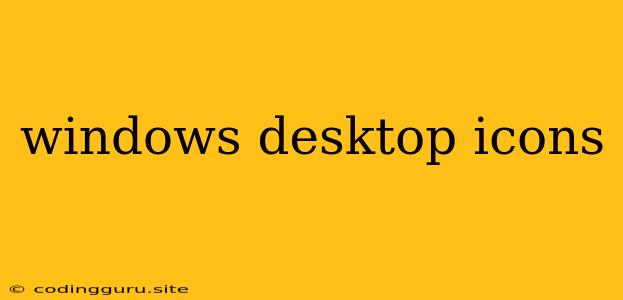Windows Desktop Icons: A Guide to Customization and Organization
Windows desktop icons are an integral part of the user interface, providing quick access to files, folders, and applications. While they can be convenient, they can also clutter your desktop and make it difficult to find what you're looking for. This article will guide you through customizing and organizing your Windows desktop icons for a more efficient and visually appealing workspace.
Understanding the Basics
What are desktop icons?
Desktop icons are small graphical representations of files, folders, and programs that are displayed on your Windows desktop. They allow you to quickly access and launch these items without having to navigate through menus or folders.
Why do we need to customize them?
Customizing and organizing your desktop icons can have several benefits:
- Improved efficiency: A well-organized desktop makes it easier to find what you're looking for, saving you time and frustration.
- Enhanced productivity: By reducing visual clutter, you can focus better on your tasks and avoid distractions.
- Personalized experience: Customize your desktop icons to reflect your personal style and preferences.
Techniques for Managing Desktop Icons
1. Removing Unnecessary Icons
- Right-click on an icon: This will bring up a context menu with options to "Delete", "Cut", or "Copy".
- Drag and drop: You can also drag unwanted icons to the Recycle Bin.
- Use the "Show Desktop" button: This button (usually located on the taskbar) will minimize all open windows and reveal your desktop, making it easier to identify and remove icons.
2. Creating Folders for Organization
- Right-click on the desktop: Select "New" and then "Folder" to create a new folder.
- Name your folder: Give it a clear and descriptive name.
- Drag and drop icons: Move icons related to a specific category into their respective folders.
- Create nested folders: For more complex organization, create subfolders within main folders.
3. Rearranging Icons
- Click and drag: Click on an icon and hold down the left mouse button to drag it to a new location.
- Use "Align Icons" option: Right-click on an empty area of the desktop and select "View". You'll find the "Align Icons" option, which allows you to arrange icons in a grid format.
4. Changing Icon Properties
- Right-click on an icon: Select "Properties".
- Customize icon: This window allows you to change the icon's appearance, its location, and other settings.
5. Utilizing Hidden Icons
- Right-click on an empty area of the desktop: Choose "View" and then "Show desktop icons".
- Toggle visibility: This option allows you to hide or display hidden icons. These icons might include system tray icons or hidden folders.
Advanced Techniques
1. Using Desktop Gadgets
- Windows 7 and earlier: You can add desktop gadgets (small applications that provide information or functionality) to your desktop.
- Windows 8 and later: The built-in Gadgets feature was removed, but you can find third-party alternatives.
2. Customizing Themes
- Change desktop background: Right-click on the desktop and choose "Personalize". This will allow you to change your wallpaper, colors, sounds, and more.
- Use themes: Themes allow you to change multiple desktop elements at once, including the background, colors, and icons.
- Use third-party themes: Many websites offer free and paid themes that can enhance your desktop's appearance.
3. Using Third-Party Tools
- Desktop organizer tools: Several software programs are available that can help you organize your desktop icons, create shortcuts, and manage files.
- Icon customization software: There are also programs that allow you to change the appearance of your icons, create new ones, and even create animated icons.
Examples of Effective Desktop Icon Management
- Organize by category: Create folders for Documents, Pictures, Music, and Downloads.
- Use color-coding: Assign specific colors to folders to quickly identify their content.
- Create shortcuts for frequently used files: Right-click on a file and choose "Create Shortcut". Drag the shortcut to the desktop.
- Group similar icons together: Place icons for related programs or files near each other.
Conclusion
Managing Windows desktop icons effectively is essential for a productive and visually appealing workspace. By following the tips and techniques outlined in this article, you can customize and organize your desktop icons to suit your specific needs and preferences. Remember to experiment with different methods and tools to find what works best for you.
